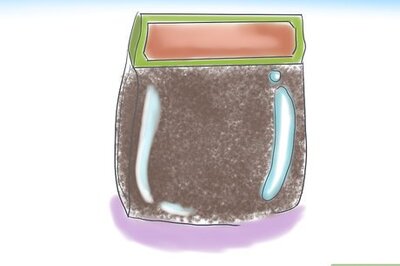
views
As world leaders huddle and haggle over emissions targets in smoky back rooms and hotels at the COP26 climate conference in Glasgow, one man is conspicuous by his absence. China’s President Xi Jinping remains bunkered in Beijing, his eyes fixed firmly on what is likely to be a defining moment for the country’s political future: the plenary meeting of the Chinese Communist Party.
Party plenary meetings are notoriously secretive. Hundreds of China’s top leaders, who constitute the Central Committee, huddle every year in Beijing, chart the course of the country’s future and disperse. Even the countrymen they rule find themselves in the dark save for a brief and perfunctory press statement describing the proceedings. Despite this, it remains possible to get at what President Xi hopes to achieve this week.
First, the facts we know. The powers that be in Beijing have indicated that President Xi introduced a historical resolution on the “major achievements and historical experiences” of the CCP as the organisation completes its 100th year in existence. Historical resolutions are a rare thing in the arcane world of Chinese politics and have been used to state the Party’s views on its history, achievements and failings. Only Mao Zedong and Deng Xiaoping have introduced similar resolutions in 1945 and 1981 respectively. While Mao wielded such a resolution as an instrument to justify his vice-like grip over the Party, Deng Xiaoping used it to call for an end to the excesses of Mao’s Cultural Revolution, which threw Chinese society into chaos and resulted in the death of millions. Through his push to redefine Chinese history, we can conclude two things about Xi’s intentions.
First, the introduction of this resolution is a clear continuation of the Chinese President’s efforts to project himself as a transformational figure in Chinese politics. From his use of a plenary meeting in 2016 to classify himself as a “core leader” to his abolition of presidential term limits in 2018, Xi has accrued power and standing like no leader since Mao. His push to reinterpret the history of the CCP, a tool used only by Deng and Mao before him, is aimed to extol his leadership and achievements while solidifying his position at the top.
Second, Xi will likely use this opportunity to define the ideology and goals of the CCP and therefore of China. Deng’s 1981 use of a historical resolution helped drive home the fact that the Maoist era was over and laid the foundation for the economic and political reforms that would transform China. Xi hopes to do nothing less.
A New Economic Model for China
It has been impossible to keep the CCP off global headlines in recent months. From a crackdown on tech czars, pop stars and private education providers alike and a drive to build self sufficiency in key technologies to refusing bailouts for massively indebted real estate companies, a major change is afoot in Chinese politics. Beijing has framed these changes through the lens of clunky and inscrutable phrases like “common prosperity”, “national rejuvenation” and the “China dream”. Xi’s ultimate goal, pithily put by China analyst Jude Blanchette, is to build a “People’s Republic of China 3.0”.
To begin with, the goal of Chinese economic development will likely be reimagined. During the Deng Xiaoping era, Beijing’s aim was to accrue wealth and resources that would help China become a “moderately prosperous society”. During a ceremony to celebrate the 100th anniversary of the founding of the CCP in June, President Xi declared that this goal had been achieved.
However, Beijing’s elites have recognised that China’s pursuit of growth at all costs has come with a hefty price tag. Income inequality has soared, standards of living have stagnated and environmental ecosystems have suffered heavy damage. At the plenary meeting, Xi will hope to reorient China to a new economic model that prioritises equitable distribution just as much as rapid growth.
One way this can be seen is in the “New Development Framework” that has chosen to de-emphasise a blind pursuit of higher GDP in favour of a more nuanced growth model that monitors innovation, environmental standards and productivity. Beijing’s pursuit of a more sustainable business model also explains its reluctance to bail out struggling property developer Evergrande. To Xi, Evergrande’s troubles are symbolic of a bygone era where businesses threw caution to the wind and pursued growth with the expectation that Beijing would foot the bill in case things went wrong.
Beijing’s crackdown on major players in China’s tech ecosystem was also born out of an increasing scepticism of consumer platform companies like Alibaba, Meituan and Didi. While the cult-like following enjoyed by tech tycoons like Jack Ma threatened the CCP, there has been a growing desire to shift private funding away from capital guzzling platform companies and towards general purpose technologies like AI and 5G.
In cracking down on a range of private firms across sectors, Xi has made it clear that he expects China’s private sector to toe the line and assist the CCP’s goals. The fact that China’s billionaires and celebrities are lining up to give up massive sums of money to a range of charitable causes points to the fact that Xi’s message has been received loud and clear. China’s gilded age will be ushered into history and will be replaced by a more equal and sustainable model.
Xi’s Vision for China 3.0
Xi’s vision for a “PRC 3.0” will also take note of the fact that China finds itself in the middle of an increasingly hostile international environment. Public perceptions of China have turned significantly negative globally while great power competition with the US and aligned powers like India has heated up. The much-vaunted “Dual Circulation” strategy and elements of China’s 14th Five Year Plan (FYP) point to Xi’s vision for his country in an age of competition. The former hopes to shift China away from reliance on international markets and towards a domestic demand-driven economic model.
Beijing has observed its bruising trade war with America, suspended trade agreement with the EU and global efforts to shift supply chains away from China with increasing disquiet. Through Dual Circulation, China hopes to focus on building high-end manufacturing and key technological capabilities domestically. American actions against 5G giants Huawei and ZTE have shaken Beijing’s leadership to its core. Determined not to lose out in the coming battle over high technology, Xi has realised that technology is national security and will undoubtedly include the same in his vision for PRC 3.0.
China’s push to localise data, step up investment in basic and advanced research and build self-reliance in key areas like semiconductors are all evidence of Beijing’s scramble to make China an innovation leader by 2035. While technological breakthroughs will help economic competition with Washington and its allies, Xi’s PRC 3.0 will also see technology deployed to serve national security interests. As efforts to better integrate the private sector with defence needs, commonly termed Military-Civil Fusion, take off, Beijing’s technological advancements will serve to magnify growing Chinese power in defence and national security.
Few things better illustrate Xi’s vision than his absence from the climate negotiations. Having made the climate concessions that he can in advance, Xi remains bunkered in Beijing focused on domestic change while world leaders seek to chart the future of climate policy in Glasgow. Xi understands that for his country’s rise to become a firm reality, it has to be China First. When China engages with the world again, it will do so on its own terms.
The author is a research associate, strategic studies programme, Observer Research Foundation (ORF). The views expressed in this article are those of the author and do not represent the stand of this publication.
Read all the Latest Opinions here




















Comments
0 comment